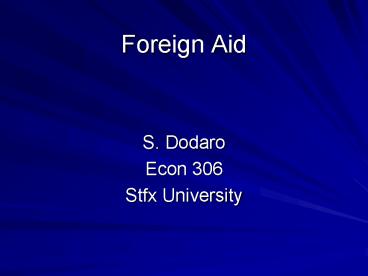Foreign Aid - PowerPoint PPT Presentation
1 / 15
Title:
Foreign Aid
Description:
Non Commercial from the perspective of the donor (i.e. ... Tied versus Untied Aid ... Untied Aid - comes with no strings attached. Problems with Tied Aid ... – PowerPoint PPT presentation
Number of Views:86
Avg rating:3.0/5.0
Title: Foreign Aid
1
Foreign Aid
- S. Dodaro
- Econ 306
- Stfx University
2
Foreign Aid Defined
- Non Commercial from the perspective of the donor
(i.e., motivated by developmental concerns) - Characterized by concessional terms (compared to
commercial loans) - Lower interest rate
- Longer repayment periods
3
The Two Gap Model
- Savings Gap
- S falls short of what can be productively
invested - Foreign Exchange Gap
- Foreign exchange earnings fall short of the
amounts required to purchase necessary inputs
from other countries - Saving s Gap I S
- where I investment S savings
- Foreign Exchange Gap M X
- where M imports X exports
4
Derivation of the Savings and Foreign Exchange Gap
- Y C I (X M)
- Sources or resources used in the economy Y M
- Uses of resources in the economy (expenditure
targets) C I X - Y M C I X
- Subtracting C from both sides we get
- Y C M I X
- Y C S
- Therefore S M I X
- S M withdrawals from the economy
- I X injections into the economy
- Rearranging we get the following
- M X I - S
- Whichever of the two is greater dominates
5
Forms that Foreign Aid can take
- Financial capital
- Physical capital goods
- Technical assistance
- Agricultural commodities
- Military equipment
6
Why is it Given
- Humanitarian Reasons
- to promote development
- Profitability (especially in the case of tied
aid) on the part of - Manufacturers of equipment and capital goods
- Sellers of intangibles (consultants, technicians,
bureaucrats, etc.) - Farmers and grain companies, etc.
- Political Reasons
- To secure political advantages
- To protect vital interests
7
Why is it Accepted
- Economic Reasons
- To supplement scarce resources
- To gain access to means to develop
- To get access to otherwise unavailable resources
- Political Reasons
- Provides leverage and legitimizes the present
leadership - Strengthens the leadership (including through
military equipment) - Provides political link with donor
8
Why is it Accepted Continued
- Moral Reasons
- As compensation for past exploitation
- To provide basic needs for the population
- Profitability reasons
- Bureaucrats and political leaders (corruption)
- Enterprises, etc.
9
Multilateral versus Bilateral Aid
- Multilateral
- Aid channeled through international organizations
(world bank, UN agencies, etc.) - less likely to be influenced by political and
other non economic considerations - may offer fewer negotiation offers for LDCs
- Bilateral
- aid channeled nation to nation
- more susceptible to non economic factors an
easier to tie to purchases from the donor - offers greater negotiation possibilities,
10
Fungibility of Aid Funds
- Aid funds aimed at certain projects can be used,
indirectly, for other purposes - funds can be easily diverted and cannot be easily
contained in rigid channels - aid can be used to free resources to use for
other purposes, projects or programs
11
Tied versus Untied Aid
- Tied Aid - aid loans need to be used to purchase
goods and services produced by the donors - These include the following
- raw materials
- capital goods and equipment
- technical advise
- transportation and insurance
- project evaluation
- Untied Aid - comes with no strings attached
12
Problems with Tied Aid
- Goods and services may not be the lowest priced
ones - lowers value of aid - goods and services may not be appropriate from
the perspective of needs and resources or
recipients - also lowers the value as well as the
development impact of aid - tends to have an ongoing characteristic or effect
as a result of need for - spare parts,
servicing, technical advise, etc. These are
normally not covered by aid
13
Consequences of Tied Aid
- Projects financed by tied aid tend to be
- capital intensive
- import intensive
- have built in import factor that requires scarce
foreign exchange - capital intensive technology is what the donors
have - recipients are precluded from shopping around for
the best prices and the most appropriate
technology
14
Food Aid
- Can free resources from food production that can
be used - to produce more export goods
- increase modern or industrial production
- replace normal imports of food and save on
foreign exchange - add to the surplus required for expansion of
urban or modern sector - food is main wage good
15
Dangers Associated with Food Aid
- Cheap food resulting from foreign aid may inhibit
agricultural development in LDCs and in the
process - Undermine the linkages between the agricultural
sector and the industrial sector - Limit agricultural exports (an important
component of export-led growth) - May establish dependence on foreign food sources
- Changing peoples tastes and preferences away
from local foods - The aid may have been provide to establish a
market (especially when it is given as a result
of price support systems in the donor countries
i.e., dumping of surpluses) - May have anti-developmental effects if not used
properly































